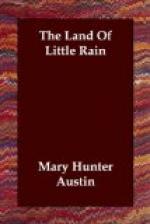I have forgotten to find out, though I meant to, whether the wild almond grew in that country where Moses kept the flocks of his father-in-law, but if so one can account for the burning bush. It comes upon one with a flame-burst as of revelation; little hard red buds on leafless twigs, swelling unnoticeably, then one, two, or three strong suns, and from tip to tip one soft fiery glow, whispering with bees as a singing flame. A twig of finger size will be furred to the thickness of one’s wrist by pink five-petaled bloom, so close that only the blunt-faced wild bees find their way in it. In this latitude late frosts cut off the hope of fruit too often for the wild almond to multiply greatly, but the spiny, tap-rooted shrubs are resistant to most plant evils.
It is not easy always to be attentive to the maturing of wild fruit. Plants are so unobtrusive in their material processes, and always at the significant moment some other bloom has reached its perfect hour. One can never fix the precise moment when the rosy tint the field has from the wild almond passes into the inspiring blue of lupines. One notices here and there a spike of bloom, and a day later the whole field royal and ruffling lightly to the wind. Part of the charm of the lupine is the continual stir of its plumes to airs not suspected otherwhere. Go and stand by any crown of bloom and the tall stalks do but rock a little as for drowsiness, but look off across the field, and on the stillest days there is always a trepidation in the purple patches.
From midsummer until frost the prevailing note of the field is clear gold, passing into the rusty tone of bigelovia going into a decline, a succession of color schemes more admirably managed than the transformation scene at the theatre. Under my window a colony of cleome made a soft web of bloom that drew me every morning for a long still time; and one day I discovered that I was looking into a rare fretwork of fawn and straw colored twigs from which both bloom and leaf had gone, and I could not say if it had been for a matter of weeks or days. The time to plant cucumbers and set out cabbages may be set down in the almanac, but never seed-time nor blossom in Naboth’s field.
Certain winged and mailed denizens of the field seem to reach their heyday along with the plants they most affect. In June the leaning towers of the white milkweed are jeweled over with red and gold beetles, climbing dizzily. This is that milkweed from whose stems the Indians flayed fibre to make snares for small game, but what use the beetles put it to except for a displaying ground for their gay coats, I could never discover. The white butterfly crop comes on with the bigelovia bloom, and on warm mornings makes an airy twinkling all across the field. In September young linnets grow out of the rabbit-brush in the night. All the nests discoverable in the neighboring orchards will not account for the numbers of them. Somewhere, by the same secret process




